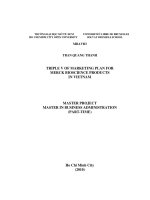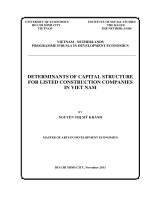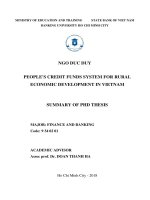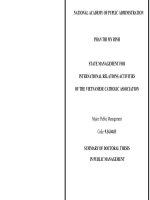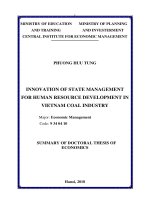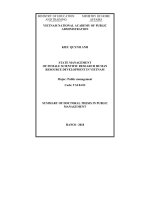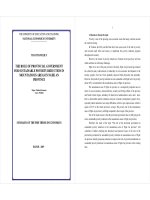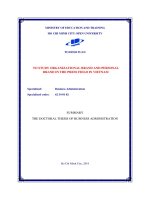Summary of Doctoral thesis of Economics: Innovation of state management for human resource development in Vietnam coal industry
Bạn đang xem bản rút gọn của tài liệu. Xem và tải ngay bản đầy đủ của tài liệu tại đây (741.21 KB, 27 trang )
i
MINISTRY OF EDUCATION
MINISTRY OF PLANNING
AND TRAINING
AND INVESTERMENT
CENTRAL INSTITUTE FOR ECONOMIC MANAGEMENT
PHUONG HUU TUNG
INNOVATION OF STATE MANAGEMENT
FOR HUMAN RESOURCE DEVELOPMENT IN
VIETNAM COAL INDUSTRY
Major: Economic Management
Code: 9 34 04 10
SUMMARY OF DOCTORAL THESIS OF
ECONOMICS
Hanoi, 2018
ii
Completed at:
CENTRAL INSTITUTE FOR ECONOMIC MANAGEMENT
Scientific supervisors: 1. Dr. Nguyen Manh Hai
2. Assoc.Prof, Dr. Mac Van Tien
Reviewer 1: Assoc.Prof, Dr. Cao Van Sam
Reviewer 2: Assoc.Prof, Dr. Vu Thanh Son
Reviewer 3: Dr. Nguyen Van Hai
This thesis defense is witnessed by Institute-level Thesis
Examination Council of Central Institute for Economic Management
at ……. on ……, 2018.
The thesis can be looked up at Libraries of:
- Central Institute for Economic Management;
- National Library, Hanoi.
1
INTRODUCTION
1. The necessity of the thesis topic
The most outstanding feature of production and Business
Management (BM) in general, Human Resource Management (HRM) in
Vietnam coal industry in specific is command of implementation and
actions. Specifically, Vietnam National Coal-Mineral Industries Group
(Vinacomin) and Dong Bac Corporation (DBCo) are the management
agencies who will set goals for branches in terms of business results,
pricing, output, labour quota, wage and the like, meaning that
enterprises are less independent, responsible and flexible in HRM.
State Management (SM) in Human Resource Development (HRD)
in Vietnam coal industry is being dispersed among the Ministry of
Industry and Trade and Ministry of Natural Resources and Environment,
the Ministry of Labor, Invalids and Social Affairs, ministries, branches
and localities having head offices of Vietnam coal industry. This makes a
unit in the coal industry can be instructed and commanded by different
ministries and localities through inconsistent guidelines; Therefore, coal
units are confused to implement coal production and business and
manpower management of Vietnam coal industry.
There have been many domestic and foreign studies on HRD from the
national, regional and group perspectives to corporate one. Most of the
research deal with the HRD from the perspective of corporate governance,
with few research on HRD from a management perspective, and no research
on SM of HRD in Vietnam coal industry. To solve the problem above, the
author selected topic: “Innovation of state management for human
resources development in Vietnam coal industry”.
2. Purpose and meaning of the study of thesis topic
* Purpose of study: The thesis proposed a number of solutions for
state management agencies and focal points of the coal industry such as
Vinacomin and DBCo to innovate and improve the SM of HRD in
2
Vietnam coal industry as well as to raise the efficiency and efficiency of
the SM of HRD in the coal industry, aiming for the sustainable
development (SD) of Vietnam coal industry in the future.
* Theoretical meaning: The thesis supplements and clarifies the
rationale of state management of human resource development of the
coal industry on issues such as concepts, objectives, contents, methods
and tools of SM of HRD. Moreover, it helps develop evaluation criteria
and elements SM of HRD of the coal industry. At the same time, it
identifies and assesses the impact of the factors on the SM of HDR of
the coal industry in the context of deep international integration today.
* Practical meaning: The thesis provides scientific arguments for
proposing a number of solutions to relevant SM agencies and local
administrations having their headquarters in raising the efficiency and
effectiveness of SM of HRD of Vietnam coal industry to meet the
requirements of coal production and trading and SD of Vietnam coal industry.
3. Structure of the thesis
Apart from introduction, conclusion, appendix and references, the
content of this thesis includes 4 chapters.
Chapter 1: Overview of state management studies on human resource
development of the coal industry.
Chapter 2: Theoretical basis of state management for human
resources development of coal industry.
Chapter 3: Current status of the state management for human
resources development in Vietnam coal industry.
Chapter 4: Orientation and solutions innovation of state management
for human resource development of the Vietnam coal industry.
3
CHAPTER 1: OVERVIEW OF STATE MANAGEMENT STUDIES ON
HUMAN RESOURCE DEVELOPMENT OF THE COAL INDUSTRY
1.1. Overview of research published at domestic and abroad related
to thesis topic
1.1.1. Overview of foreign studies
The researches on State Management for HRD in the coal industry is
approached from macro perspective and addressed the following issues:
Firstly, build a well-educated and appropriate HR through training
and HRD from the industry to country level.
Secondly, HR as a source of capital, if used well, will greatly
contribute to the development of industries and countries.
Thirdly, SM of HRD in the coal industry of countries in the world
with developed mining industries such as Germany, China and Indonesia
focus on issues such as forming strategy HRD, ensuring labor safety and
SD of the coal sector of the country.
1.1.2. Overview of research in the country
First, HRD in enterprises researches and proposes solutions to HRD
in enterprises. The main researched subjects are technical workers and
managers at State-owned enterprises, small and medium enterprises in
Vietnam, electricity enterprises, textiles and garments, high quality human
resources, managers at groups and corporations with State capital.
Secondly, the SM of HRD of the coal industry includes studies on
attracting HR, motivating people to work, analyzing and assessing the
HRD of coal industry.
1.1.3. The issues of the thesis have not been researched and solved in
publicized studies
- Most of previous studies on HRD from the perspective of corporate
management, a few research from perspective of SM for HRM.
- There is no study on the concept, role and assessment criteria of
state management for HRD in Vietnam coal industry.
- There is no study on the contents, methods and tools of SM for
HRD in Vietnam coal industry.
1.1.4. Critical issues will be researched and solved in the thesis
Firstly, the development of the HR of the coal industry needs to be
approached from the perspective of SM of HRD at the sectorial level.
4
Secondly, the thesis clarifies the practical basis of SM for HRD in
Vietnam coal industry.
Thirdly, the SM of HRD in Vietnam coal industry needs to be
managed in a way that is effective, consistent and highly sustainable.
1.2. Directional resolution of researched issues in the thesis
1.2.1. Research objectives of the thesis
The thesis proposes several innovative solutions to SM for HRD of
Vietnam coal industry that help to enhance efficiency and effectiveness
of SM for HRD towards sustainable development of Vietnam coal
industry in future
1.2.2. Research questions of the thesis
Firstly, what are the research perspective, content, method, used
tools, impact elements, and assessment criteria and indicators of SM for
HRD on Vietnam coal industry?
Secondly, what are issues of SM for HRD on Vietnam coal
industry till 2025.
Thirdly, what we need to innovate SM for HRD on Vietnam coal
industry till 2025 to achieve sustainable development of human
resources as well as Vietnam coal industry.
1.2.3. Research subjects and scope of the thesis topic
- Research subjects: theoretical and practical issues of SM for
HRD in Vietnam coal industry.
- Scope of work:
+ Content: HRD in Vietnam coal industry follows target approach.
SM of HRD in Vietnam coal industry follows management process:
Strategic planning; Policy issuing; Policy implementing; Inspecting; and
testing HRD in Vietnam coal industry.
+ Scope: The thesis majorly studies coal exploration, investigation,
construction, investment, and exploitation enterprises; and coal screening
and processing enterprises managed by Vinacomin and DBCo - Defense
Ministry.
+ Time: Real circumstances of SM of HRD of Vietnam coal industry
in the period 2010-2016, secondary database of 2016 and 2017. Several
solutions to SM of HRD of Vietnam coal industry till 2025.
5
1.2.4. Research approach and research method of the thesis
1.2.4.1. Theoretical analysis framework of the thesis
Research process:
Topic, on line, policy, war of
HRD in Vietnam coal industry
Factors affecting:
* International context
* Macro environment
* The coal industry
* Enterprises, workers
Tasks and requirements on
SM for HRD in Vietnam coal
industry
SM for HRD
in Vietnam coal
industry
Strategic
orientation in
HRD
Policy,
legal
framework
in HRD
Organization of
implementation
in HRD
Solutions
of SM for HRD in
Vietnam coal
industry
Limitations,
causes of limitations
Inspection,
testing,
supervision
in HRD
Figure 1.1. Analysis framework diagram of the thesis
1.2.4.2. Approach of research subjects
SM of HRD of Vietnam coal industry follows management process:
Strategic planning; Policy issuing; Policy implementing; Inspecting; and
Testing HRD of Vietnam coal industry.
1.2.4.3. Research method; collecting and processing information and materials
* Research method: The author uses several research methods
namely: descriptive statistics, exploratory factor analysis (EFA),
6
professional methods.
* Collecting secondary information and materials: Pulished statistics
database, reports of management agencies as the Governemnt, General
Statistics Office of Vietnam, Ministry of Foreign Affairs, Vinacomin, DBC –
Defense Ministry, Vietnam Coal Enterprises.
* Collecting primary information and materials:
- Survey: Respondents are Vietnam coal companies, specifically 92
enterprises questionnaires devided into 2 groups: (i) Managers at
Vinacomin and DBC; (ii) Head of Administration Department – HR
Department of enterprises.
- Data processing: Collected and investigated data is analyzed by
SPSS 20.0 software and comparatively analyzed by excel.
- Measurement scale formation and accreditation: To measure
implementation level of 18 elements based on 04 assessment criteria of SM
for HRD of Vietnam coal industry, the author uses the identification scale
and Liker scale with 05 levels that fits to each specific criteria. To indentify
credit and suitable level of scale, the author uses Cronbach Anpha
coefficient of statistics analysis of IBM SPSS Statistics 20.0 software. The
majority of researchers agreed that Cronbach Anpha factor at 0.7 or higher
is usable, but Cronbach Anpha value at 0.63 or higher (DeVeliss, 1991) is
usable in SM for HRD of Vietnam coal industry that is a new concept.
CHAPTER 2. THEORETICAL BASIS OF STATE MANAGEMENT
FOR HUMAN RESOURCE DEVELOPMENT OF COAL INDUSTRY
2.1. Human resources of coal industry, HRD in the modern market
economy and international integration
2.1.1. Human resources of coal industry
2.1.1.1. Concept and features of human resources in coal industry
- Concept: HR of coal industry is the entire workforce in the coal
enterprises at a certain time, which is expressed by quantity, proportion, and
quality and working ability of each employee contributing to common goals
7
of coal enterprises.
- Features: Coal industry use a large number of employees; direct
employees account for a major proportion, the majority of labour are male
under 40 years old. Coal employees often work underground in deep level
and hard working environment which harms to their health as they
frequently engage to such harmful sustances as methane and carbon. At the
same time, manufacturing locations of coal enterprises are mainly
mountainous and remote ares with poor transportaion. It is true that coal
exploration must be accompanied with the environmental protection.
2.1.1.2. Human rerource market in coal industry
Human resource demand in coal industry: HR demand tends to
decrease due to competetion pressure leading to reduce labour to boost
productivity. HR supply is rare in the circumstance of intensively international
integration and touch compatition of well-qualified, trained, and management
labour. HR market of coal industry in the context of intensively international
integration has 02 basic features, which are the shortage of management labour
and well-qualified workers with international standard tranining (supply is less
than demand), and the redundancy of indirect workers and direct workers who
are fail to meet international standards (supply greater than demand).
2.1.2. HRD of coal industry in the condition of modern market and
international economic integration.
2.1.2.1. Concepts
- Modern economic market: is the economy of humanism,
competition, equality that motivates capable people as well as supports
incapable ones to share opportunities to everyone.
- International economic integration: is the process that countries do
activities to enhance cohesion among countries based on shares of benefits,
goals, value, resources, and power as well as comply common rules within
international institutions or orgranisations.
- HRD of coal industry in the condition of modern economic market
and international economic - economic integration: is the process to ensure
enough quantity, reasonable scale, quality improvement of human resource,
8
productivity improvement to meet requirements of manufacturing and
current and future business activities; towards sustanable development and
standardization of the global coal industry.
2.1.2.2. Requirements for HRD of coal industry in the condition of modern
economic market and international economic - economic integration
- Training human resource to meet social needs, and regional and
international standards.
- Enhane the quality and efficiency of training, using coal labour is the
piority.
2.1.2.3. Content, method of HRD in the coal industry in the condition of
modern economic market and international economic integration
a. Content of HRD in the coal industry
- Ensure human resource quantity.
- Rationalize human resource structure.
- Enhane human resource quality
- Improve productivity.
b. Method of HRD in the coal industry
- Develop labour market of the coal industry.
- Invest in HRD in the coal industry.
- Expand and strengthen connection among coal industry with
enterprices inside and outside the industry in HRD.
- Enhance management capability of HR in the coal industry.
- Develop training facilities of coal industry to meet requirements of
international economic integration and 4.0 industrial revolution.
2.2. State management for human resources development in the coal industry
2.2.1. Concepts and some theories of SM for HRD in the coal industry
- Concept: SM for HRD in the coal industry is impact of the state on HR
of the coal industry to create sufficient workfoce in terms of quantity,
reasonable structure, high quality and productivity; employees works in a
dependent, creative ways and have long-term commitment to the sector,
towards sustanable development of HR.
9
- Basic issues of SM for HRD in the coal industry:
+ Management targets: High productivity; independent and creative
employees, long-term commitment to the coal industry and sustainable
development of the national coal industry.
+ Management subjects: Ministries and its agencies directly managing
the national coal industry. Management objects: Economic Groups and
Corporations of coal enterprises.
+ Management content: follows process of SM for HRD in the coal industry.
+ Management method: Management subjects affect management objects
through some basic methods namely: Economic method, administrative
method, educational method. During implementation, they combine and apply
flexibly metioned methods to aquire the highest efficiency and effectiveness.
+ Management tools: Management subjects deploys 04 tools: legal, plan,
policy, and national assets.
2.2.1.3. Several theories of SM of HRD
a. Theory of administrative managment for public orgranisations
Henry Fayol (1841-1925, Istanbul, Turkey) is the author of theory of
administrative management in France, who is the pioneer of modern
management theory. H.Fayol supposes that administrative management is
projection, plan, organisation, control, combination and examination. The
theory is applied to research on SM for HRD in the coal industry.
b. Theory of modern management of Kaizen of Masaaki Imai
Masaaki Imai (1930-now, Tokyo, Japan), Kaizen means “Innovation,
improvement”. In Kaizen, all business activities must lead to customers’
incremental satisfaction. The theory will be applied to research on SM for HRD
in the coal industry.
2.2.2. Content, method of SM for HRD in the coal industry
2.2.2.1. SM content for HRD in the coal industry
SM for HRD in the coal industry is a process including: (i) Strategic
orientation of HRD in the coal industry; (ii) Build and issue legal framework for
10
HRD in the coal industry: Policy of attracting and recruiting labour for the coal
industry, policies of training and HRD of the coal industry; (iii) Implement HRD
of coal industry; (iv) Inspection, examination, supervision, management HRD in
the coal industry.
2.2.2.2. Method and tools of SM for HRD in the coal industry
a. Administration-organisation method: decisions are specified in the
forms of regulations and rules of organisations relating to attracting, recruiting,
using, treating and training and HRD for coal enterprises.
b. Economic method: The State concretized methods through policies
such as wage policy for furnace workers, emulation-reward policy for mining
workers, national HRD policy, HRD policy for coal industry.
c. Psychological-educational method: Propagandizing and analyzing to
help people understand difficulties, challenges ,and opportunities to overcome
together current and future difficulties of national coal industry.
2.2.3. Innovate State management for HRD in the coal industry
2.2.3.1. Concept of innovation of SM for HRD in the coal industry
Innovation of SM for HRD of coal industry is creative changes of
methods or tools of management subjects and management objects to enhance
efficiency and effectiveness of SM; improve productivity, quality and
effectiveness of HR in the coal industry.
2.2.3.2. Inevitability of innovation of SM for HRD of Vietnam coal industry
- SM for HRD is dispersed among functional and managing agencies,
among Ministry of Labor, Invalids and Social Affairs, Ministry of Education
and Training, Ministry of Health, and Ministries and localities having offices
of Vietnam coal enterprises.
- Many legal regulations are issued, but less consistent and low
enforcement.
2.2.4. Assessment criteria of SM for HRD of coal industry
Applying to research objects and output model of manufacturing and
business activities of Vietnam coal industry, assessment criteria and indicators
of SM for HRD of Vietnam coal industry.
11
Table 2.1. Assessment criteria of SM for HRD of coal industry
Criteria
Sign
Assessment criteria
HL1
HL2
HL3
Effectiveness
HL4
HL5
HL6
HL7
HQ1
HQ2
Efficiency
HQ3
HQ4
PH1
Suitability
PH2
PH3
BV1
BV2
Sustainability
BV3
BV4
Requirement extent of HR to HR strategy and plan and
coal manufacturing and business activities.
Full-up extent of policy of HRD of coal industry
Support extent of Group, Corporation to HRD of coal
enterprises
Policy follow extent of attracting and recruiting HR
Policy follow extent of labour safety and protection
Policy follow extent of assessment policy of work
commitment, emulation, and rewards for employees
Commitment extent of wage and incentive policy
Productivity completion extent compared to plan
Manufacturing and business completion extent compared
to plan
Ability of bringing benefits when doing HRD to the
development of coal industry
Ability of saving costs of Manufacturing and business
activities of coal industry after applying HRD activities
Suitability extent of legal framework of SM for HR
employment in enterprises
Suitability extent of targets of HRD plans and HR
employment of coal
Suitability extent of HRD policy of coal industry and
national HRD strategy
Connection extent of HRD policy and national HRD
strategy
Suitability extent of HR quality, structure and sustainable
strategy of coal industry
Enhancement and suitability extent of HR quality and
sustainable strategy of coal industry
Deployment and assignment job extent of HR to be
reasonable and effective for sustainable strategy of coal
industry
2.3. Elements impacting on effectiveness and efficiency of SM for HRD
of coal industry
The coal industry does business in an market economy and intensively
international integration; SM for HRD of coal industry is affected by 02
12
elements namely: (i) Objective factors (ii) Subjective factors as Figure. 2.2.
below:
Figure 2.2. Elements impacting on SM for HRD of coal industry
2.4. Experience of SM for HRD of coal industry in some countries and
lessons for Vietnam
Experience of SM for HRD of coal industry in some countries with
a developed mining industry such as Germany, Japan, China helps to build
05 lessions learned for Vietnam: Firstly, enhancing effectiveness and
efficiency of HRD. Secondly, building long-term and highly practical HRD
strategy. Thirdly, recruiting management is critical. Fourthly, vocational
training for coal employees to equip them practical and effective skills.
Finally, wage and welfare management of employees based on job
efficiency.
CHAPTER 3: CURRENT STATUS OF THE STATE MANAGEMENT
FOR HUMAN RESOURCES DEVELOPMENT IN THE
VIETNAM COAL INDUSTRY
3.1. Overview of the coal industry and human resource development for
Vietnam coal industry
3.1.1. Overview of the Vietnam coal industry
Vietnam coal industry has a history of over 175 years, with 79 years of
13
glorious tradition, from the total strike on November 12, 1936 of more than
3,000 miners won a brilliant victory. In the beginning of the 1990s, Vietnam
coal industry faced severe difficulties and challenges.
VIETNAM COAL INDUSTRY
Vietnam Coal and Mineral
Industries Group
* Coal industry
* Mineral industry
* Electrical industry
* Industry explode materials
* Other jobs
Dong Bac Corporation
* Coal industry
* Mineral industry
* Building materials industry
* Manufacturing industry
* Other jobs
Figure 3.1. Main business fields of Vietnam coal industry
The coal industry consists of Vinacomin, DBCo formerly the same
unit. By 2014, DBCo was separated from Vinacomin and under the
overall management of the Ministry of Defense. Vinacomin and DBCo
are the two leading units of the state-owned coal industry and account for
100% of charter capital.
3.1.2. Current situation of human resources development in Vietnam
coal industry
According to the data collected and Figure 3.3 and Figure 3.4, the
scale of the HR of the coal sector in Vietnam has not changed significantly,
and the motivation to attract labor to the coal industry from the workforce is
not big. The structure has not changed sharply in the direction of reducing
indirect HR, not really suitable with the current market mechanism.
14
Figure 3.3. Number of HR in Vietnam coal industry in 2010-2016
Figure 3.4. Structure of HR by title for period 2010-2016
3.2. Current status of the state management for human resources
development in Vietnam coal industry
3.2.1. Current situation of strategic orientation for human resource
development in Vietnam coal industry
- The coal industry has built up a workforce with the goal:
“Intellectual + Loyalty + Discipline + Concentration = Win”.
- To build and develop a system of training establishments at all levels
of the coal industry in a synchronized and modern manner meeting the
national, regional and international standards.
15
- Good localization and traditionalization of human resources.
- Prioritize the treatment of heavy, hazardous and dangerous workers
(especially in pit mines).
- Maintaining and developing the traditional culture and corporate
culture of the Vietnam coal industry.
3.2.2. Creating a legal framework for human resources development in
Vietnam coal industry
3.2.2.1. Policy of attracting the smelters into the Vietnam coal industry:
The coal industry has implemented a policy of attracting workers since
they were miners. Vinacomin and DBCo have instructed and coordinated the
training institutions and enterprises to strengthen the communication on
regimes and policies for the students to learn the pit industry; electrical
engineering, transportation. Support for working conditions, treatment
policies for workers working in the pit.
3.2.2.2. Recruitment policy:
All employees recruited into Vietnam coal industry must pass the
form of recruitment to ensure the quality of labor, with priority given to
children who are land recovered for investment projects, children
employee's death due to labor accident.
3.2.2.3. Priority policy for workers working in coal mines:
Occupational preferential policies such as labor restructuring policy,
renovation of rehabilitation policy. Maintain preferential welfare regimes
for workers working in the pit and implement social security within the
entire coal industry.
3.2.2.4. Use policy, human resources:
To implement preferential policies in accordance with the actual
conditions of the school so as to create the most favorable conditions for
students to study successfully after graduation in the long service in the coal
industry. To maintain and improve the efficiency of the implementation of
preferential regimes for smelters, heavy and harmful laborers.
3.2.2.5. Human resource training and development policy:
16
To concentrate on training and raising the qualifications of the
existing contingent of technicians; additional training for missing, weak
points; To build up a coalition of employees and workers in both quality
and quantity so that they can master the advanced technologies and
equipment. To develop a number of specialized training schools in the
field, striving to build Vietnam-based College of Mining and Mineral
Resources up to international standards.
3.2.3. Organizing the development for HR in Vietnam coal industry
3.2.3.1. Attracting and recruiting workers into Vietnam coal industry:
Annually, the number of newly recruited employees contributes nearly
10% of the total labor force of the whole coal industry in Vietnam,
indicating a great change in the human resources in the sector and more
than 50% of the additional labor force. The sector is a new source of
employment from the labor market.
3.2.3.2. Employing and treating workers in Vietnam coal industry:
- Wages: upward trend in the period 2010-2016, especially from
2014 to 2016 when DBCo separated from Vinacomin, the wages of labor
significantly increased coal industry; In 2014 the average in this industry
was 8.625 million VND/person-month and direct labor of 12.750 million
VND/person-month. By 2016, the direct labor wage was 13.275 million
VND/person-month, increasing by 2.894 million/person-month, which was
27,87% higher than that of 2010.
- Welfare: Every year, the units organize convalescence, visit the resort
for workers and laborers. According to the survey, 88.7% of the workers
were held by the company for convalescence or vacation. In 2014 and 2015,
the total number of workers for rest, rehabilitation and rehabilitation are
13,139 people; The number of days for each nursing period is 11 days with
the cost of one day nursing and rehabilitation is 205,000 VND/day, nursing
and rehabilitation after lung washing is 237,000 VND/day.
3.2.3.3. Training and fostering HR in Vietnam coal industry
17
The coal industry directly manages two training centers, namely the
Vietnam College of Coal and Mineral Industries and; Vinacomin
Business School.
Among the sectors that have been trained at university or higher, main
majors are the mining and mechanical engineering majors, the number of
post-graduate graduates and the number of trained graduates.
Cooperative training with local and foreign universities: The Vietnam
coal industry has actively cooperated with universities in Russia, Poland,
China, Germany and Japan. A number of prestigious universities and
vocational training institutions in the country.
3.2.4. Inspecting and examining the HRD of Vietnam coal industry
At the central and local levels, the strengthening of the inspection
system, the strengthening of inspection, anti-corruption, corruption and
waste are now considered as a focus in state management HRD. Labor
inspection activities are not strong enough to inspect all incidents arising in
the relationship between employers and workers with more than 100
enterprises in Vietnam coal industry. The inspection, examination and
handling of violations in the implementation of policies and laws on human
and HRD have not been regular in time and are not serious enough.
3.3. Assessing the efficiency and effectiveness of the state management
for human resources development in the Vietnam coal industry
a. The results of the measure of effectiveness
Basically, managers believe that human resources have a certain
contribution to the business and development strategies of the coal
industry in Vietnam. The implementation of policies is effective, with the
high rate of approval proportion of businesses which is from 40 to 60%.
b. Results measure the effectiveness
The efficiency of the state management of HRD is also measured by
the efficiency of coal production in Vietnam. The coal industry is always
interested in increasing labor productivity for workers and improving
18
their productivity. Business efficiency with the high rate of approval of
enterprises over 40%.
c. Results of measurement of suitability
Legal aspects of HRD are not suitable with the current use of human
resources in Vietnam coal industry in, with the rate of confusion and
disagreement of enterprises is still high over 50%.
d. Results of sustainability
The quantity, structure of human resources, layout, arrangement and
use has not changed positively for the development of human resources in
Vietnam coal industry, the rate of confusion still high, which is 44.6%.
e. Some limitations and causes of limitations
- The strategic orientation of HRD of Vietnam coal industry is in
line with the strategic documents and plans for the development of the
coal industry by 2025, not yet quantified into specific targets.
- Create a legal framework and organize the implementation of
planning, plans and policies on HRD in Vietnam coal industry: Some
units are still quite rigid in implementing related policies. For example,
the salary gap between positions and occupations is not linked to the
nature of work. New recruiters are not diversified, so businesses still have to
receive labor but not really satisfied. As for the recruitment in the leadership
positions, still the most common traits of the familiar secondhand dominant
employment results. The coordination between schools and businesses is not
synchronized, some enterprises have not clearly expressed the role of selfmanagement of HR, but entrusted to schools in the recruitment of HR. The
investment in training and HRD of enterprises is not well prepared.
- The work of HRD in Vietnam coal industry has not been very drastic.
CHAPTER 4: ORIENTATION AND SOLUTIONS INNOVATION
OF STATE MANAGEMENT FOR HUMAN RESOURCE
DEVELOPMENT OF THE VIETNAM COAL INDUSTRY
4.1. Context and advantages and disadvantages of innovation SM for
human resource development in Vietnam coal industry to 2025
19
4.1.1. Context of innovation state management for human resources
development in the coal industry of Vietnam until 2025
In a flat world like today, all resources must be integrated and highly
competitive. Hence, it requires countries, industries and businesses to
prepare for integration soon. Vietnam is a country that actively integrates
and participates in multilateral and bilateral international economic
integration.
4.1.2. Advantages, difficulties and requirements innovation SM for
human resources development in Vietnam coal industry
4.1.2.1. Advantages
At present and in the future, Vietnam coal industry, Vinacomin and
DBCo have many comparative advantages compared to other units.
Vinacomin is an economic group with the State holding the chartered
capital at the controlling level, assigned by the State to manage the
majority of important natural resources such as coal and some important
minerals. Vinacomin also has a transparent and effective business strategy.
4.2.1.2. Difficulties
- SM of HRD faces the renewal of the business model and growth
model of Vietnam coal industry.
- SM of HRD in Vietnam coal industry faces difficulties in resource
depletion and climate change;
- SM of HRD in the coal industry in Vietnam with the industrial
revolution 4.0.
4.2. Objectives, viewpoint and direction of innovation SM for human
resource development in Vietnam coal industry to 2025
4.2.1. Viewpoint of innovation state management for human resource
development in Vietnam coal industry
- Identify the role of HRD in the production and business of Vietnam
coal industry.
- It is necessary to separate the core role of the Government into
orientation, creating and serving HRD activities.
- SM of socialization of investment in HRD of Vietnam coal
industry.
- Renovation of SM of HRD of Vietnam coal industry by 2025 must
go hand in hand with administrative reform and must be linked with the
20
socialist-oriented economic integration and international economic
integration.
4.2.2. Orientation of innovation state management for human
resources development in Vietnam coal industry to 2025
- SM of HRD of Vietnam coal industry towards international
economic integration.
- Complete the legal framework for HRD of the coal industry.
- To promulgate and implement policies on HRD of the coal industry
in Vietnam in the direction of meeting the needs of the society as a
whole.
- The inspection and examination of the HRD of the coal industry
towards autonomy and self-responsibility of the units; The sanctioning of
violators is strong enough, strictly and fairly.
4.3. A number of key solutions to innovation state management for
human resources development in Vietnam coal industry to 2025
4.3.1. Innovation for human resources development orientation in
Vietnam coal industry
Set the objective of HRD of the Vietnam coal industry in line with the
State's undertakings, policies and laws. To plan the development of the
human resources of the coal industry in the national socio-economic
development master plan and the national HRD plan of each locality with
the head office of the coal industry of Vietnam. Strengthening the forecast
of HRD and HR needs. Having specific criteria and norms on the size and
structure and quality of HR and labor productivity in line with the demand
for development of Vietnam coal industry.
4.3.2. Complete the legal framework for human resource development
in Vietnam coal industry
4.3.2.1. Creation of a legal framework for the human resource
development in Vietnam coal industry
- To review and perfect the system of legal documents regulating the
coal production and trading activities in order to strengthen the SM of
coal production and trading.
- Improve the legal basis for the labor market.
- Planning and development of job placement establishments.
- Formulation of the informal labor market management policy.
21
- Formulating and implementing policies on training, fostering,
rewarding and rewarding talented people.
4.3.2.2. Improve policies to attract and retain employees
- Continuing to maintain the work of living, working conditions,
housing for laborers working in pits, doing particularly heavy, hazardous
and dangerous jobs.
- Implementing the policy of using less labor, paying high salaries at
a reasonable level to retain high quality workers.
- Implementing the supplementary pension insurance policy to
attract and retain positions where labor plays a decisive role in the
stability and development of each enterprise and the coal industry.
4.3.2.3. Improve the recruitment policy of human resources
- From 2018 onward, we will continue to carry out all units of policy
on recruiting human resources through recruitment examinations with all
employees recruited into Vietnam coal industry.
- With the characteristics of mining in the pit, miners play a very
important role in production and business, so the health of the miners are
of prime concern, labor safety is on over.
4.3.2.4. Improve the training policy and coal mining sector
- Vinacomin, DBCo need to improve the capacity of training facilities,
teachers for the specialized training field.
- Improving the quality of vocational training for workers and
laborers. To form a number of advanced training establishments of the
region, linking training with technology transfer and experimental
production at a number of mines.
- Vinacomin, DBCo build up the contingent of workers and workers in
the coal industry of Vietnam with high quality, sufficient quantity in a
reasonable structure, suitable to the requirements of each enterprise.
4.3.3. Innovate the regulation of State and organize for human
resources development in Vietnam coal industry
a. Innovate to attract, recruit human resources into the coal industry
- Innovation of the recruitment of mine trainees.
- Innovation of training at the University.
- Innovation of training and production practices.
- Innovating the quality of vocational training.
22
b. Renovation of training and HRD in the coal industry in the context of
international integration
- Plan, renovate, rearrange, invest and build a system of training
schools of the coal industry in line with international standards.
- To build a contingent of teachers into key personnel in improving
the quality of human resources in the coal industry.
- Regularly paid attention to the investment in facilities for schools
to improve the quality of education and training.
- Improve the management capacity and improve the quality of the
human resources of the coal industry.
- To expand and raise the efficiency of international cooperation on
mining.
4.3.4. Strengthen the inspection, supervision and supervision for
human resources development in Vietnam coal industry
- The State performs the function of creating a legal framework and
examining, inspecting and supervising law enforcement and creating a
healthy competitive environment in the field of coal production and
trading.
- Strengthening the inspection team of Vietnam coal industry at all
levels. Complete the legal framework for inspection, monitoring and
evaluation of units in the energy sector in general and coal production
and trading in particular.
- Expeditiously reorganize and build up a team of highly skilled
military personnel as well as expertise.
- Institutionalizing and strengthening the implementation of
vocational training monitoring and quality assessment at coal industry
facilities.
4.4. Conditions for implementation of solutions to innovate the SM
for human resources development in Vietnam coal industry
In order to improve the quality of the labor force, the renovation of
state management of human resources development in Vietnam coal
industry in the coming time requires the participation of the whole
political system, State enterprises, Vinacomin, DBCo, People's
Committees of provinces and cities having their headquarters in the coal
industry, and enterprises and workers in Vietnam coal industry.
23
CONCLUSION
SM for HRD in Vietnam coal industry in the context of modern
market economy and international economic integration, bilateral and
multilateral economic agreements that Vietnam participates in, especially
the context of public revolution. The fourth and fierce competition from
the international labor market. The issue of theoretical and practical
research on SM for HRD of Vietnam coal industry will contribute to
improving the effectiveness, efficiency and sustainable development of
Vietnam coal industry in the future.
The author's thesis entitled “Innovation of state management for
human resource development of Vietnam coal industry” has obtained the
following results:
(1) The author has systematized the theoretical basis of SM for HRD
of the coal mining in terms of concepts, objectives, contents,
methodologies, tools and criteria for assessment of SM for HRD of the
sector. Experiences on SM for HRD in the coal mining in countries
around the world and lessons learned in Vietnam coal industry.
(2) The thesis analyzes the current status for HRD in Vietnam coal
industry; analyzing and evaluating the state of the SM of the coal mining
industry of Vietnam under the management process; evaluated according
to 04 criteria of effectiveness, efficiency, relevance and sustainability and
concretize into 18 indicators of SM assessment of Vietnam coal mining;
This brings out the achievements and advantages as well as the limited
aspects of SM in Vietnam coal industry.
(3) The author also proposed a number of measures to modernize
the state management of the HR to meet the development strategy of the
coal industry, the requirements of coal production and trading activities to
2025 and vision to 2030.
+ Reinforce the strategic orientation in Vietnam coal industry,
clearly, fully, reasonably and sustainably for the development in Vietnam
coal industry.
+ To improve the legal framework for Vietnam coal mining such as:
(i) policies on attracting and recruiting HR; (ii) priority policy on labor in
